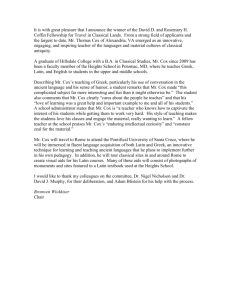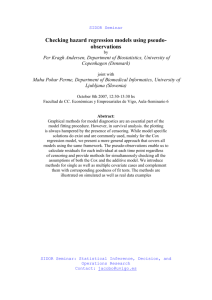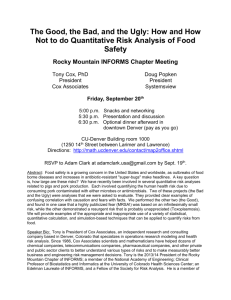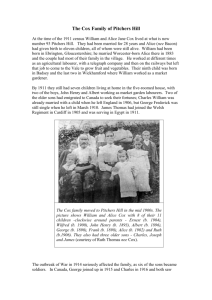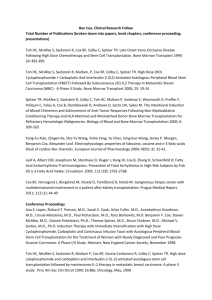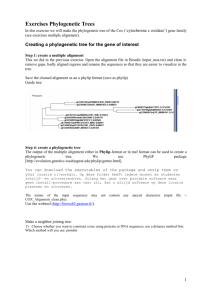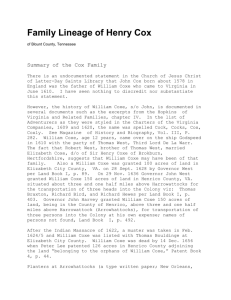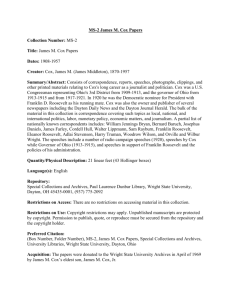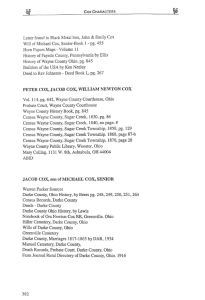Cox
advertisement
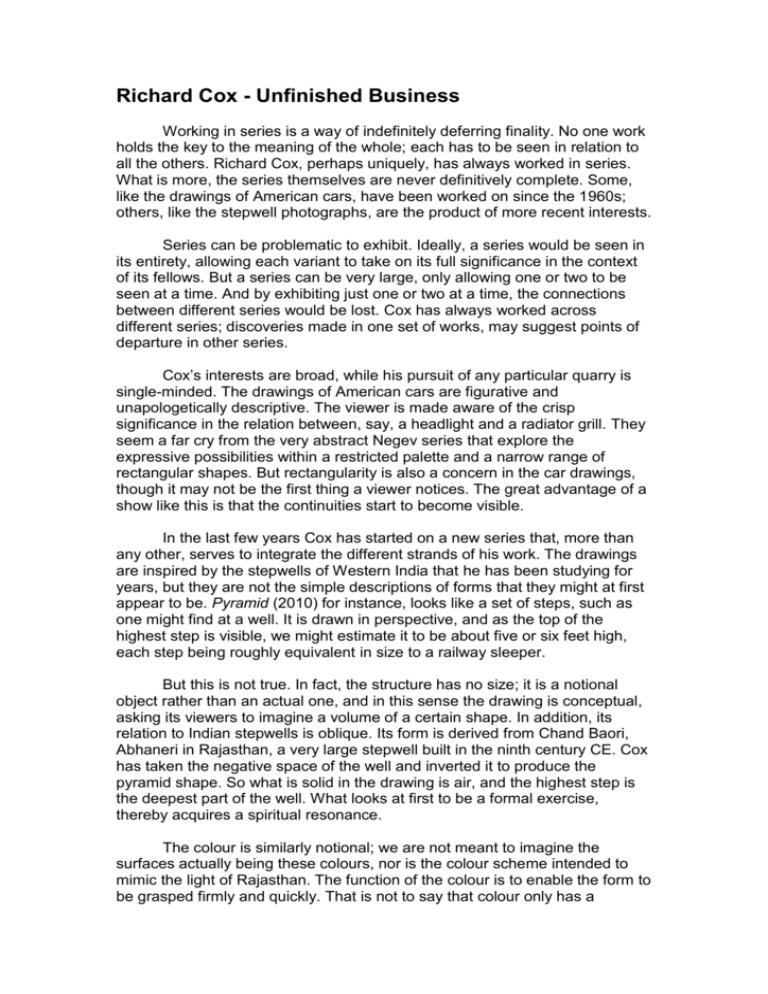
Richard Cox - Unfinished Business Working in series is a way of indefinitely deferring finality. No one work holds the key to the meaning of the whole; each has to be seen in relation to all the others. Richard Cox, perhaps uniquely, has always worked in series. What is more, the series themselves are never definitively complete. Some, like the drawings of American cars, have been worked on since the 1960s; others, like the stepwell photographs, are the product of more recent interests. Series can be problematic to exhibit. Ideally, a series would be seen in its entirety, allowing each variant to take on its full significance in the context of its fellows. But a series can be very large, only allowing one or two to be seen at a time. And by exhibiting just one or two at a time, the connections between different series would be lost. Cox has always worked across different series; discoveries made in one set of works, may suggest points of departure in other series. Cox’s interests are broad, while his pursuit of any particular quarry is single-minded. The drawings of American cars are figurative and unapologetically descriptive. The viewer is made aware of the crisp significance in the relation between, say, a headlight and a radiator grill. They seem a far cry from the very abstract Negev series that explore the expressive possibilities within a restricted palette and a narrow range of rectangular shapes. But rectangularity is also a concern in the car drawings, though it may not be the first thing a viewer notices. The great advantage of a show like this is that the continuities start to become visible. In the last few years Cox has started on a new series that, more than any other, serves to integrate the different strands of his work. The drawings are inspired by the stepwells of Western India that he has been studying for years, but they are not the simple descriptions of forms that they might at first appear to be. Pyramid (2010) for instance, looks like a set of steps, such as one might find at a well. It is drawn in perspective, and as the top of the highest step is visible, we might estimate it to be about five or six feet high, each step being roughly equivalent in size to a railway sleeper. But this is not true. In fact, the structure has no size; it is a notional object rather than an actual one, and in this sense the drawing is conceptual, asking its viewers to imagine a volume of a certain shape. In addition, its relation to Indian stepwells is oblique. Its form is derived from Chand Baori, Abhaneri in Rajasthan, a very large stepwell built in the ninth century CE. Cox has taken the negative space of the well and inverted it to produce the pyramid shape. So what is solid in the drawing is air, and the highest step is the deepest part of the well. What looks at first to be a formal exercise, thereby acquires a spiritual resonance. The colour is similarly notional; we are not meant to imagine the surfaces actually being these colours, nor is the colour scheme intended to mimic the light of Rajasthan. The function of the colour is to enable the form to be grasped firmly and quickly. That is not to say that colour only has a secondary function in these drawings. Far from it, the powdery pigment spills out onto the white sheet with a restless energy. The most striking feature of Pyramid, however, is the set of additional steps or spurs that are aligned in the drawing so as to form a kind of stack or tower. In so doing they struggle to free themselves from the three-dimensional form of which they are a part, and push towards the surface of the paper. It is an effect that can only be achieved through perspective, but one which seems to counteract the purpose of perspective as a means of fixing the position of objects in space. This introduces a radical element of abstraction into the picture, by which means, the viewer is made aware of the flat trapeziums and rhomboids that make up the ‘stack’ of spurs, and by extension, the essential flatness of all the other shapes on the picture surface. There is a further visual anomaly included in the space beside the lowest spur. There, three planes meet and describe a recessed cube-like space. As has often been noted, such forms can suddenly flip and appear to protrude out into space rather recede as it should. As with the stack, the reversible cube is an inevitable part of the perspectival construction, and yet it works against perspective’s smooth functioning. Having identified this first reversible shape, it is possible to work one’s way up the pyramid reversing each level. Nor is this simply an idle pastime, because the ideas of reversal and inversion lie at the heart of this work. Pyramid thus treads a fine line between abstract shape and concrete object, between documentation and fantasy, between perspective construction and its subversion. It is sharp-edged and quietly insistent. It does not deal in impressions, but describes a specific entity. It asks us to visualise this entity very precisely; this quality of attention is something we find throughout Cox’s work, and is a constant feature whether the object is abstract or representational, documentary or conceptual. He works within the minimalist tradition but seeks to adjust it in order to maintain its relevance today. The great achievement of minimalism was to have radically reduced the number of elements that composed an artwork. However, their success spelt their demise, because there are only so many elements that can be removed before an object stops being an artwork altogether. Cox has sought a solution to the impasse of minimalism by turning outwards, looking beyond the western tradition. He has studied and drawn Japanese temple architecture for many years, and, more recently, Indian stepwells. The longstanding sacred use of geometry in both cultures has enabled Cox to re-attach minimalist formal concerns to lived experience. In some respects his interest in American cars has served the same purpose. As elements of popular culture, the cars have been quoted numerous times by Pop artists, but they have rarely, if ever, been subjected by an artist to such a sustained analytic scrutiny as Cox brings to bear upon them. And when regarded in that way, they do not look so different from the sculpture of Sol LeWitt or Donald Judd, in their investigation of formal rhythms and the junctions between different materials. The series of which Pyramid is a part is important because it shows how themes carry over from one series to another. It enables us to see how the conceptual is embedded in the figurative and how documentary tendencies sit alongside the more fantastic elements in his work. Looking at them, we come to realise that abstraction and figuration are not necessarily opposed, and that a rigorous formalism is compatible with a concern about the place of art in the wider world. It would be foolish however to think that this series represented the last word on the subject; at some point in the future, something unpredictable will spark his interest, a new series of works will begin, and a whole new set of relationships will come into focus. Richard Cox still has unfinished business in the studio.


